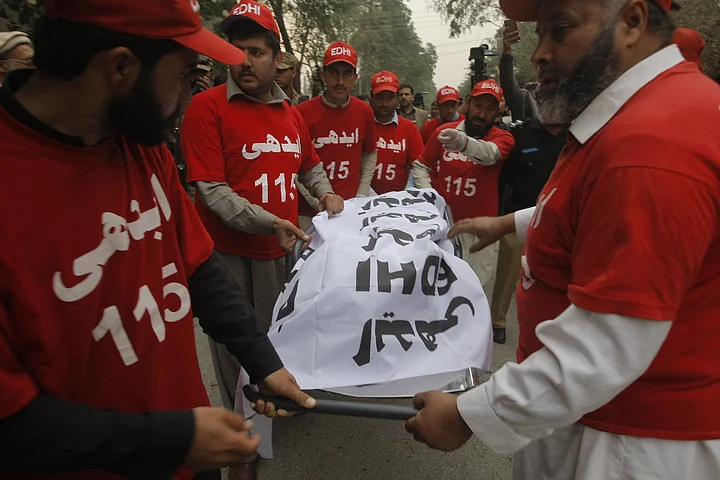It is said that the dhammal - a devotional dance held at the shrines of saints – has been held everyday without respite at the Lal Shahbaz Qalandar shrine since the 13th century. Twenty-four hours after the shocking blast at the shrine on Thursday evening, devotees once again gave rhythm to the message: “Terrorism will not break King Lal Shahbaz Qalandar’s creed of peace, love and harmony.”
Also Read: ISIS Targets Sufi Shrine in Pakistan, Kills 72 in Bomb Blast
The state too had a message. Soon after, Prime Minister Nawaz Sharif described it as “an attack on the progressive future of Pakistan“, and called on security forces to use full force against extremists, “wherever they may be, inside or outside.” Within 24 hours, law enforcement claimed to have killed 100 suspected militants across the country. Details on who they are or which terrorist group they are affiliated with are sketchy.
Army chief General Qamar Javed Bajwa was more direct, vowing revenge after the suicide attack: “No more restraint”.
His meaning was made clear as the border with Afghanistan was sealed, and Afghan embassy officials were summoned to the GHQ in Rawalpindi, where they were handed a list of over 76 terrorists, allegedly masterminding attacks on Pakistan.
Pakistan Government Hits Back Hard
To reinforce the Afghan connection, the army claimed to have attacked and destroyed a militant camp just across the Afghan border. The Army Chief also called US General John Nicholson, Resolute Support Mission in Afghanistan, expressing his “concern over continued acts of terrorism in Pakistan with impunity from Afghanistan.”
It appears as if the state machinery has kicked into gear, as the Prime Minister promised, within and without. But reactively, as security analysts and newspaper editorials have pointed out.
Also Read: 100 Militants Killed: Pakistan’s Crackdown After Sufi Shrine Blast
The blast at the shrine in Sehwan was the bloodiest end to a bloody week: a reminder that ‘normal’ in Pakistan is a lull between fear, grief and pain. We were told that the “backs of terrorist groups” had been broken. That splinter groups might stage the odd large-scale attack, perhaps on soft targets, but it just demonstrates their weakness. That we have cracked down on militancy of all stripes, without discrimination.
This last week skewered those claims.
So, we tried to seek patterns to understand this renewed surge in terrorist violence. It’s hard, though: the attacks have taken place from north to south, targeted government and law enforcement officials as well as civilians, been claimed by a number of militant groups.
Of State Diplomacy and the Afghan Problem
What connects Tehreek-e-Taliban Pakistan faction Jamaatul Ahrar, to Baloch nationalist group Baloch Liberation Front, to global terror group, the so-called Islamic State?
Retired army generals and those close to the establishment say Afghanistan and by extension, India. They claim that attacks in Pakistan mirror attacks taking place in Afghanistan. They also say Afghan President Ashraf Ghani is now firmly in the Indian camp.
But handing over a list of terrorist leaders based in Afghanistan to Afghan officials will yield little cooperation, given that our Afghan policy is in shambles and the trust deficit seemingly insurmountable. President Ghani’s condemnation of the Sehwan bombing claimed by the so-called Islamic State and statement that Afghan security forces are fighting all terror groups, including IS, is an indication from the Afghan side that ‘hey, we’re doing all we can’.
Islamic State: The Elephant in the Room
In Pakistan, Islamic State is the elephant in the room.
Journalists, and provincial home department reports have repeatedly waved the red flag over the growing footprint of the global terror group in the country since 2014. Sectarian groups like Lashkar-e-Jhangvi for instance, already well-entrenched here, are affiliates. A terrorism researcher at the military funded National Defense University, based in Islamabad, told me the so-called Islamic State is now the biggest threat in Pakistan, but neither the civilian nor the military leadership are publicly acknowledging this.
So, if cooperation with Afghanistan is wishful thinking, the state can at the very least, launch a sustained and comprehensive crack down on the terror networks, sympathisers, seminaries, and facilitators within Pakistan.
This last week, private WhatsApp groups and social media has been littered with security warnings about possible threats to public spaces.
Fear stalks us again, whispering we are not safe – not in schools, parks, mosques, universities or at protests; not at shrines, where the colour of love is a bloody red.
(Amber Shamsi is a multi-media journalist who has worked for international and national media organisations as a reporter and on the editorial desk. She currently hosts a news and current affairs show on Dawn TV. This is an opinion piece and the views expressed above are the author’s own. The Quint neither endorses nor is responsible for the same.)
